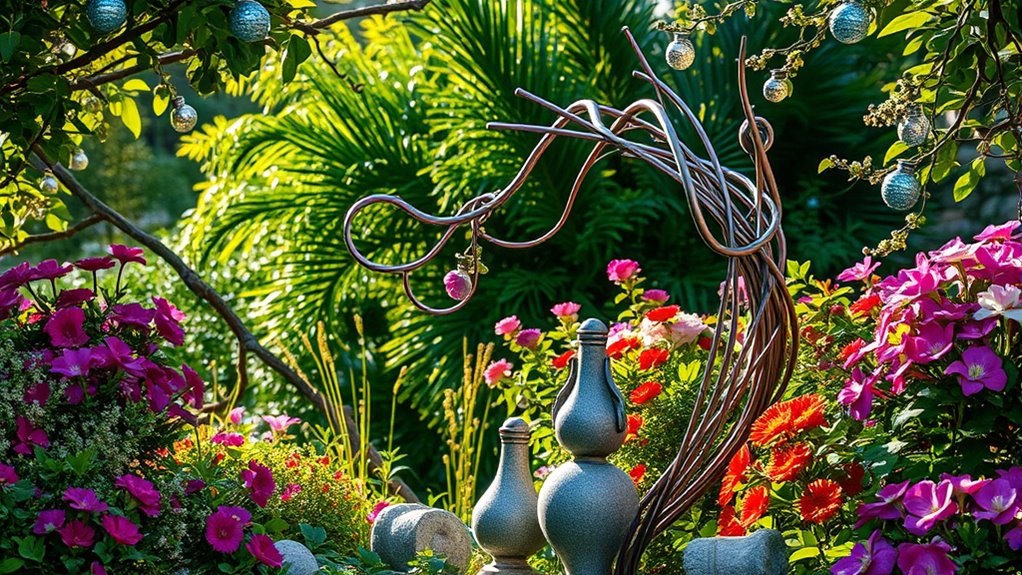To install outdoor sculptures and décor in your garden, start with careful planning by evaluating your space and choosing focal points that suit your style. Prepare the site by removing debris and excavating for a stable foundation, selecting durable support structures like concrete or gravel. Use proper anchoring and handling techniques for large pieces, and select weather-resistant materials such as stone or metal for longevity. Learn about DIY shaping and ongoing maintenance to keep your garden art looking great over time.
Key Takeaways
- Plan sculpture placement considering garden style, visibility, lighting, and material contrast for visual impact.
- Prepare the ground by clearing debris, excavating, and adding drainage layers to ensure a stable foundation.
- Choose appropriate support structures and anchors based on sculpture weight, material, and environmental conditions.
- Select durable, weather-resistant materials like bronze, stone, or treated wood for longevity outdoors.
- Use proper handling equipment and techniques for installation, and conduct regular maintenance to preserve the artwork’s stability and appearance.
Planning Your Garden Sculpture Placement
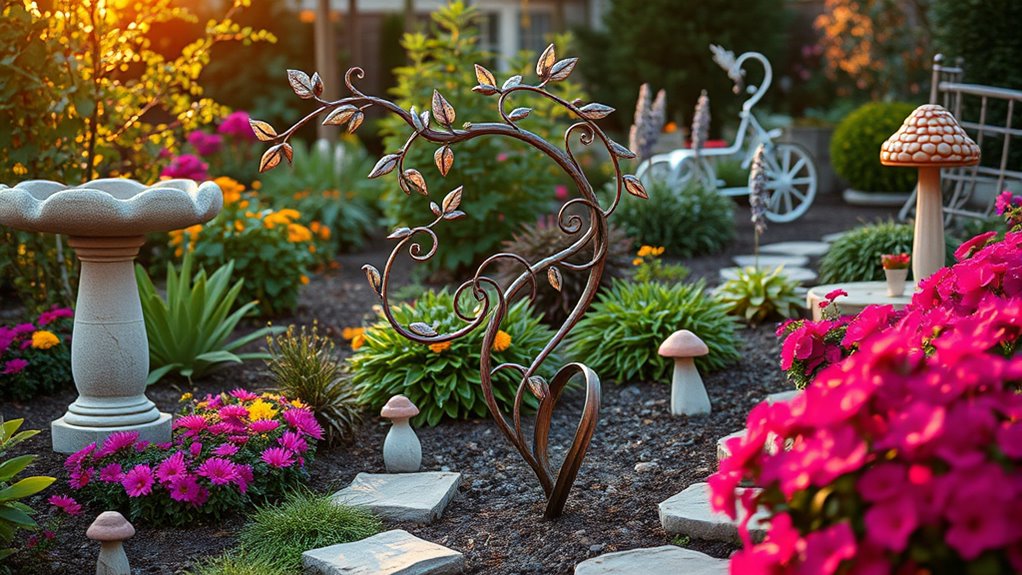
Have you considered how the placement of your garden sculpture can shape the overall aesthetic and flow of your outdoor space? Your garden style influences where your sculpture fits best, helping establish visual focal points that draw attention. Decide if it should serve as a centerpiece, a subtle accent, or a statement piece conveying a message. Position sculptures to break monotony and create specific interest points, ensuring they’re visible from key viewpoints and garden access areas. Use greenery like bushes and hedges to naturally frame and integrate the sculpture. Consider the sculpture’s size and scale relative to surrounding plants and features to maintain balance. Play with contrasting materials and lighting to enhance visibility and impact, making sure your sculpture complements the overall garden design. Additionally, the material you select can influence how well your sculpture withstands outdoor conditions and how it ages over time. Incorporating proper lighting can further highlight your sculpture’s features and ensure it remains a focal point during evening hours.
Preparing the Site for Installation
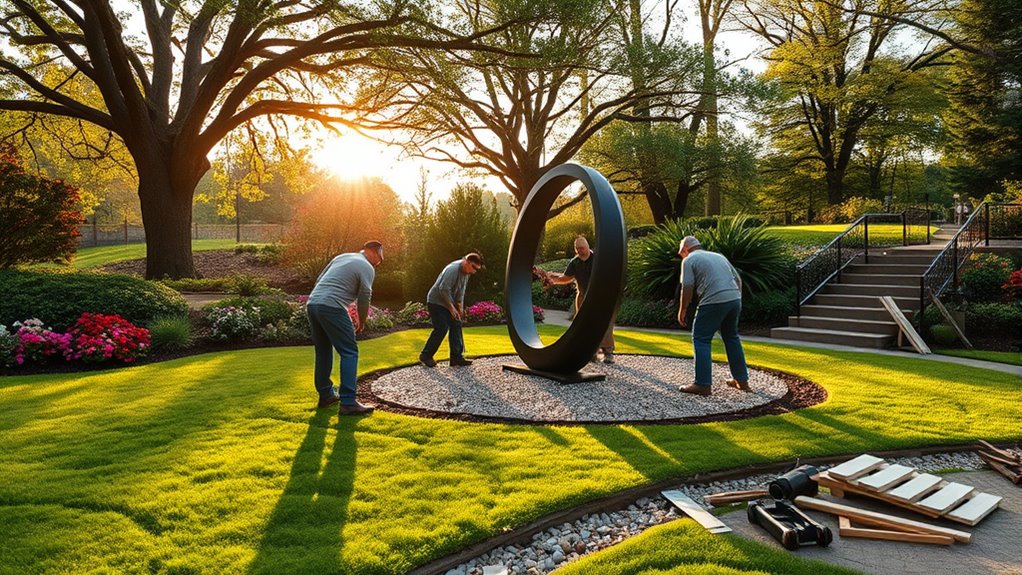
Before installing your sculpture, you need to evaluate the site carefully to identify any obstacles and plan the layout properly. Clear the ground of vegetation, rocks, or debris to create a stable, level surface. This groundwork guarantees your sculpture will be secure and durable in the outdoor environment. Additionally, using steel bars or iron frames, you can further ensure stability by anchoring the sculpture securely to the ground, which is especially important for outdoor art installations exposed to weather conditions.
Site Evaluation and Planning
To guarantee outdoor sculptures withstand environmental challenges and remain safe for public interaction, thorough site evaluation and planning are essential. You need to assess soil conditions through soil testing to ensure proper drainage and stability. Pest control measures should be considered to protect materials from damage. Examine site factors such as drainage, exposure to wind and abrasive particles, and risks from nearby activities or debris falling from overhangs. These factors can cause deterioration or hazards. Use the table below to help prioritize site concerns:
| Aspect | Potential Issue | Mitigation Strategy |
|---|---|---|
| Soil & Drainage | Water accumulation causing damage | Improve drainage and test soil |
| Wind & Particulates | Surface erosion or surface damage | Choose sheltered locations |
| Public Interaction | Climbing or touching causing wear | Install barriers and signage |
| Overhangs | Debris falling onto sculptures | Remove or trim overhangs |
| Environmental Exposure | Prolonged exposure leading to deterioration | Select durable materials suitable for outdoor conditions and plan for regular maintenance. An understanding of environmental resilience can further inform material choices. |
Ground Preparation and Clearing
Proper ground preparation and clearing are essential steps to guarantee a stable foundation for outdoor sculptures. Start by removing all vegetation, roots, rocks, and debris that could compromise foundation stability. Clear the surface of leaves, twigs, stones, and old construction remnants, ensuring the site is free from loose topsoil prone to shifting or erosion. Excavation should go to a suitable depth, considering the sculpture’s size, foundation, and drainage needs, while avoiding underground utilities. After excavation, remove loose soil and debris to create a clean base. Compact the soil thoroughly using a plate compactor or tamper to increase soil strength and prevent future settling. Adding a layer of gravel or sand enhances drainage and stabilizes the surface, helping your sculpture stand firm for years to come. Additionally, understanding the contrast ratio of your chosen materials can influence how well the sculpture maintains visual impact in varying lighting conditions.
Choosing the Right Foundation and Support Structures
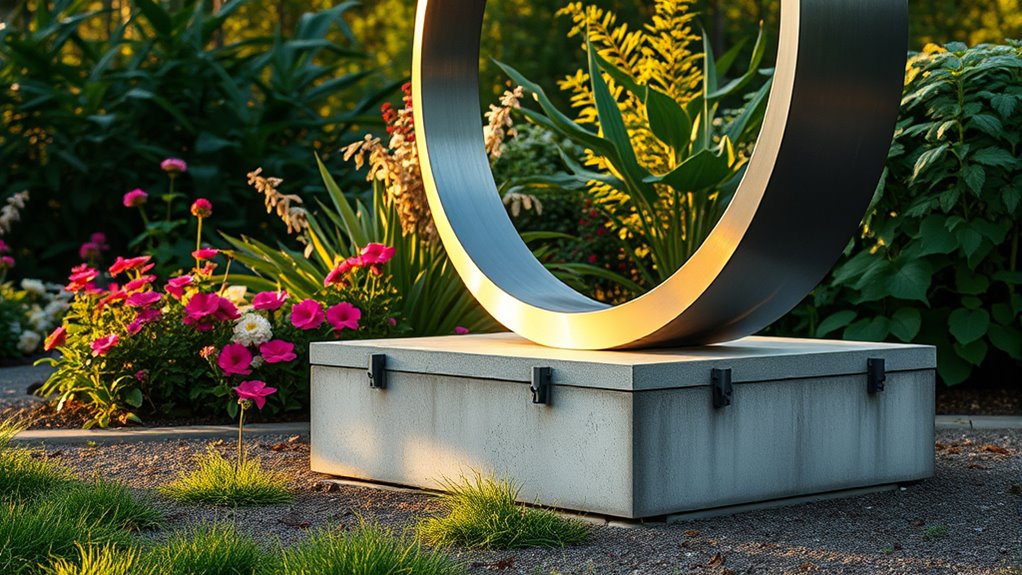
Choosing the right foundation and support structures is vital for ensuring your outdoor sculpture stays secure and looks great over time. You need to take into account materials that match the sculpture’s weight and environment, as well as designs that provide stability and durability. By carefully selecting foundation types and support systems, you can prevent shifting or damage and keep your art safe for years to come. Additionally, selecting materials that are compatible with outdoor conditions helps to prevent corrosion or deterioration, ensuring the longevity of your sculpture. Incorporating an understanding of attention in creative practice can also assist in designing innovative and resilient support solutions that adapt to various environmental challenges.
Foundation Material Selection
Selecting the right foundation material is essential for guaranteeing the stability and longevity of outdoor sculptures. You need to consider material compatibility to match the sculpture’s weight and type, whether stone, metal, or resin, to prevent shifting or sinking. For heavy sculptures, a dense-graded crushed stone or concrete slab offers strong support and distributes weight evenly. Proper foundation inspection helps identify soil conditions—clay, unstable ground, or freeze-thaw risks—that influence your choice. Materials like crushed stone and sand promote drainage, reducing frost heave and water damage, while concrete provides durability for weight-bearing pieces. Always ensure your foundation is well-prepared, with layered, compacted materials, to support your sculpture effectively and minimize future maintenance needs. This careful selection guarantees a stable, lasting installation by preventing movement or settling over time.
Support System Design
Designing an effective support system for outdoor sculptures involves carefully integrating foundation and support structures to guarantee stability and durability. You need to choose the right anchor types, such as penetrators, arrowheads, or bullet anchors, based on soil conditions and sculpture weight. Proper anchor placement is vital; it must align precisely with mounting points to withstand external forces like wind load. Assess the maximum expected wind pressures to determine the necessary anchor strength and reinforcement. Use corrosion-resistant materials and protective coatings to ensure longevity against moisture and pollutants. Support structures—typically metal frameworks—must distribute weight evenly to prevent point-load failures. Equipment like cranes and alignment tools will help during installation, ensuring the sculpture remains stable and secure against wind and environmental stressors. Ensuring proper installation techniques and regular maintenance checks are also crucial for long-term stability and safety. Additionally, consulting with structural engineers can provide valuable insights into load distribution and enhance the overall support system design.
Long-term Stability
To guarantee long-term stability of outdoor sculptures, it’s essential to use the right foundation and support structures tailored to environmental conditions and load requirements. Choosing materials like concrete provides weather resilience and creates a durable, level base, while crushed stone offers excellent drainage and stability, preventing water pooling. The foundation’s soil compatibility is vital; selecting permeable, well-compacted bases like dense-graded layers minimizes erosion and resists shifting. Proper excavation, with straight, level sides, ensures secure placement, and filling with stabilizing materials like gravel-sand mixtures increases strength. Anchors or bolts can be embedded for added security against wind or seismic forces. Regular inspections and maintenance help identify early signs of movement or erosion, guaranteeing your sculpture remains stable and resilient over time.
Safely Handling and Positioning Large Art Pieces
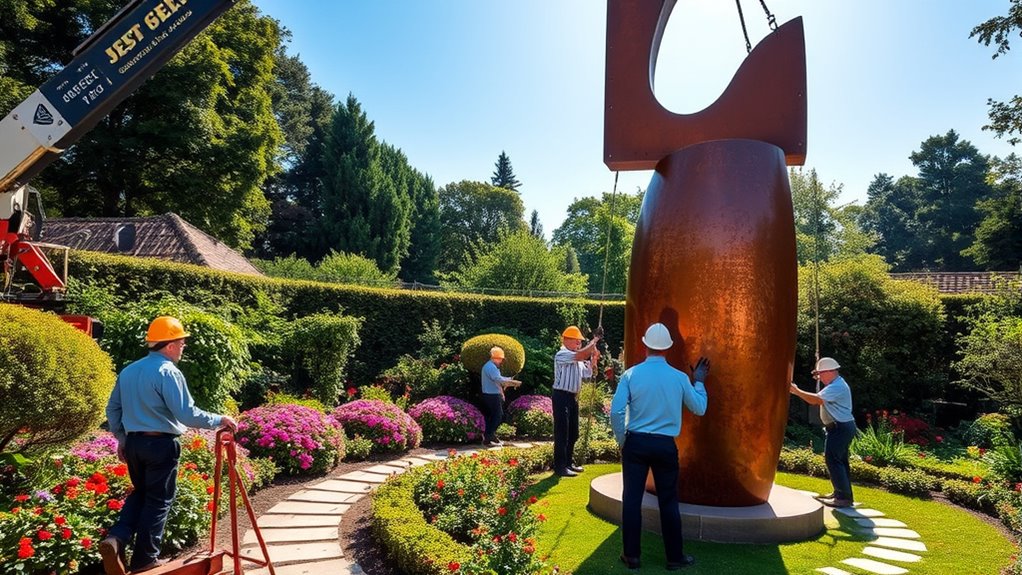
Handling and positioning large outdoor art pieces requires careful planning and precise execution to guarantee safety for both the artwork and the installation team. Start by evaluating the sculpture’s weight and dimensions—over 200 kg may need engineering consultation. Identify fragile areas to avoid damage during lifting or transportation, and use protective padding like foam or blankets to prevent scratches or chips. Confirm the installation site is cleared and leveled to support the sculpture properly, considering soil or foundation reinforcement. Select appropriate lifting equipment such as cranes or forklifts, using specialized straps that support the sculpture’s shape without damaging delicate surfaces. Team coordination is essential for safe handling. Proper planning helps preserve art conservation standards and reduces risks during sculpture cleaning and positioning. Additionally, understanding the essential oils for handling stress and anxiety can improve team focus and safety during complex installations.
Securing Sculptures With Proper Mounting Techniques
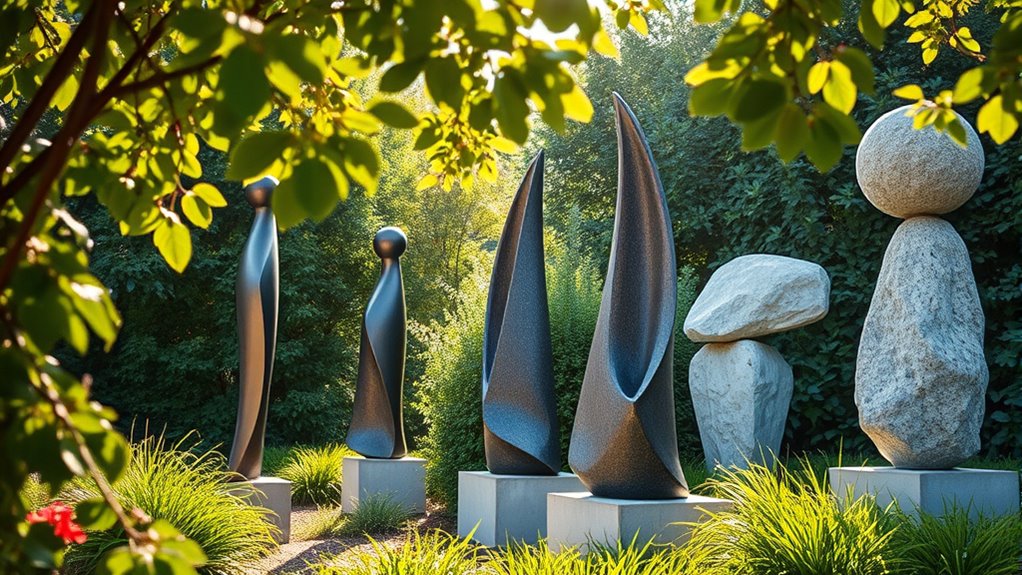
Once you’ve prepared a solid, level foundation for the sculpture, the next step is to secure it firmly using proper mounting techniques. Your goal is to ensure stability and safety, which depends on effective anchoring techniques and correct fastener selection. Choose anchors such as bolts, screws, or mounting plates compatible with your sculpture’s material. Proper alignment of anchor points ensures even load distribution and prevents tilting. Embed rebar or anchor rods into the concrete for added strength, especially for larger pieces. Gradually tighten fasteners to avoid damage. Use the table below to guide your mounting approach:
| Technique | Details |
|---|---|
| Anchoring techniques | Bolts, brackets, embedded rebar |
| Fastener selection | Compatible with sculpture material and weight |
| Alignment | Ensure proper positioning during installation |
| Leveling | Use levels for precise vertical and horizontal placement |
| Final checks | Confirm all fasteners are tight and secure |
Additionally, consulting retail store hours can help ensure you have enough time to complete your installation without rushing.
Selecting Materials for Durability and Weather Resistance
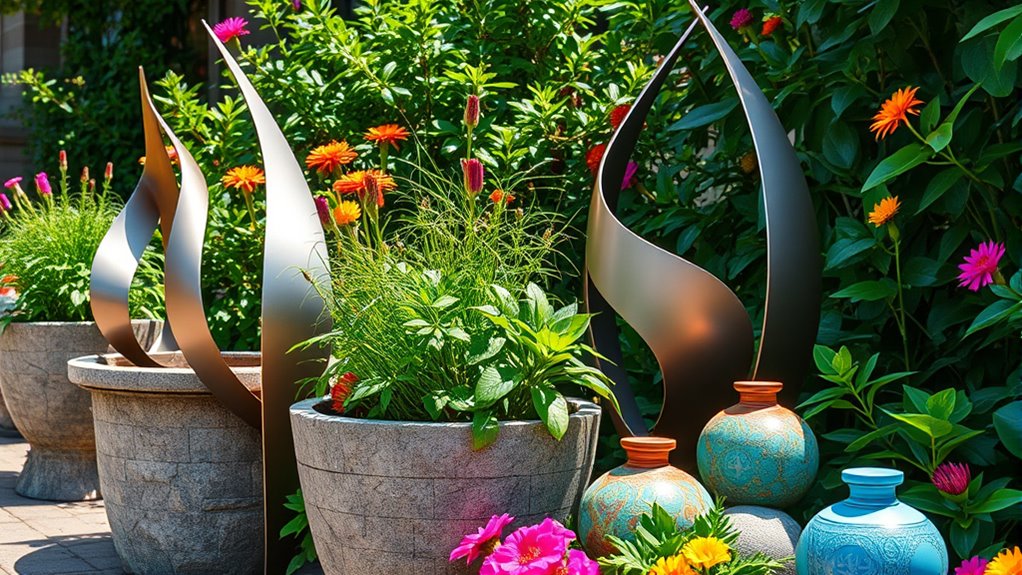
Choosing the right materials is essential for ensuring your outdoor sculpture withstands harsh weather conditions and maintains its appearance over time. To maximize material durability and weather resistance, opt for metals like bronze, stainless steel, or aluminum, which resist corrosion and require minimal maintenance. Natural stones such as marble, granite, and limestone offer excellent weather resistance and low porosity, making them ideal for enduring temperature fluctuations. Fiberglass and resin sculptures are lightweight, resist UV damage, moisture, and temperature changes, making installation easier. Protect organic materials like wood with waterproof sealants and UV finishes, but remember they’re less durable long-term. You can also consider modern weather-resistant composites that combine aesthetic flexibility with enhanced durability, ensuring your outdoor art remains vibrant and intact for years to come.
Building and Shaping DIY Outdoor Sculptures
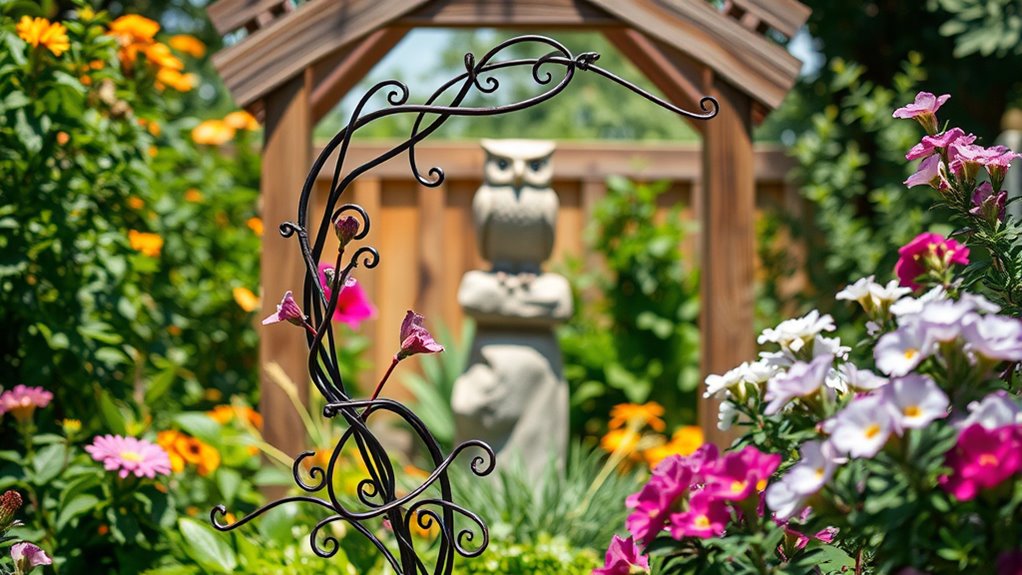
Building and shaping DIY outdoor sculptures starts with creating a sturdy internal framework that can support the outer materials and withstand weather conditions. Use wireframe structures like chicken wire or mesh to define the shape, reinforcing thin or extended areas with bent metal rods or thicker wire for added support. Fill the frame with lightweight materials such as crumpled newspaper or styrofoam to bulk the form and provide a base for the outer shell. Secure everything tightly with wire wrapping to guarantee structural rigidity. When applying mortar or papercrete, layer carefully, letting each dry to prevent cracks. For sculpture finishing and artistic detailing, carve textures or features into the surface, add decorative elements, and refine uneven areas for a polished, durable outdoor piece that withstands the elements. Incorporating weather-resistant materials can further enhance the sculpture’s longevity outdoors.
Maintaining and Caring for Garden Art Over Time
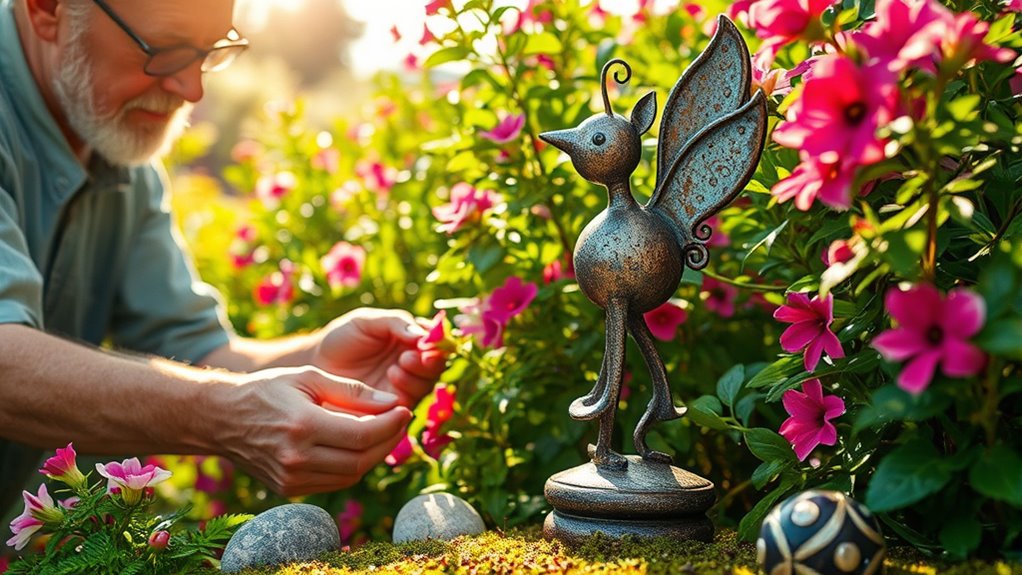
To keep your garden art looking its best over time, regular maintenance is essential. Proper care prevents damage and preserves beauty. Start with regular cleaning: use a soft cloth or brush to remove dirt, leaves, and debris. Rinse gently with a garden hose, avoiding harsh sprays. Use mild soap and water, steering clear of abrasive cleaners. Dry sculptures promptly to prevent moss or mold growth. Consider applying waterproof coatings or sealants seasonally to protect surfaces from water damage and UV fading. For pest prevention, inspect sculptures regularly for signs of damage or pests, and address issues early. Incorporating proper cleaning techniques can extend the lifespan of your sculptures and maintain their visual appeal.
- Clean with soft tools and gentle rinses
- Apply waterproof coatings and sealants
- Protect from pests and environmental stressors
- Inspect and repair cracks or chips promptly
Frequently Asked Questions
How Do I Prevent Theft or Vandalism of Outdoor Sculptures?
To prevent theft or vandalism, you need effective security measures and concealment strategies. Place sculptures in well-used, visible areas and install bright lighting at night. Anchor them securely and add physical barriers like mulch or decorative rocks. Use security cameras and motion detectors for real-time monitoring. Conceal valuable parts with landscaping or embedding them into structures. These steps deter criminals, increase surveillance, and protect your outdoor art from damage or theft.
What Are the Best Seasonal Precautions for Outdoor Art?
Think of seasonal weather as nature’s unpredictable dance partner, requiring you to adapt your outdoor art care. To protect your sculptures, you should follow seasonal precautions: elevate pieces during winter, cover or store them to guard against frost, and check for damage in spring. During summer, shade and clean regularly, and in autumn, prepare for rain with covers. These steps help guarantee your art remains vibrant and well-preserved, just like resilient plant protection.
How Can I Ensure My Sculpture Remains Stable During Strong Winds?
To keep your sculpture stable during strong winds, focus on foundation stability and wind-resistant design. Position it near sturdy structures or use concrete bases for added weight. Confirm the sculpture’s design is balanced and uses weather-resistant materials. Secure it with anchors like deep stakes, bolts, or natural elements like rocks. Regularly inspect and maintain anchoring points, adjusting as needed to prevent wobbling and displacement during gusty conditions.
Are There Eco-Friendly Materials Suitable for Outdoor Sculptures?
You want to know about eco-friendly materials for outdoor sculptures, right? Sustainable materials like recycled metal and resin are excellent choices, as they’re durable and environmentally conscious. Biodegradable options, such as organic waste or natural fibers, add a natural touch and break down over time. By choosing these materials, you support eco-friendly practices and create garden art that’s both beautiful and gentle on the planet.
How Often Should I Inspect Outdoor Sculptures for Damage?
Imagine giving your outdoor sculptures the gentle attention they merit. You should follow a maintenance schedule that includes inspections every six months, using a detailed inspection checklist to spot early signs of wear or damage. Routine visual surveys between formal checks help you catch issues early. For high-value pieces, consider professional evaluations every 2-3 years. Regular care ensures your art remains stunning and protected for years to come.
Conclusion
As you bring art to life in your garden, remember that each sculpture is like a silent storyteller, standing alongside the timeless beauty of nature. With careful planning and proper care, your outdoor art becomes a lasting monument—much like a modern-day sculpture garden or a silent guardian of your outdoor sanctuary. Embrace the process, and let your garden become a living canvas where creativity and nature intertwine forever.
